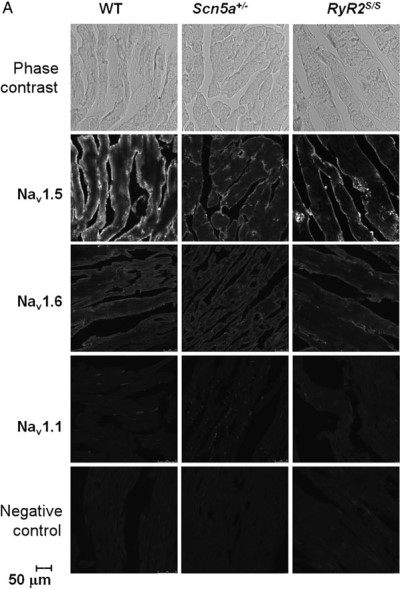Overview
- Peptide DRLPKSDSEDGPRALNQLS(C), corresponding to amino acid residues 493-511 of rat NaV1.5 (accession number P15389). Intracellular loop between domains I and II.
 Western blot analysis of rat heart membranes:1. Anti-NaV1.5 (SCN5A) (493-511) Antibody (#ASC-005), (1:200).
Western blot analysis of rat heart membranes:1. Anti-NaV1.5 (SCN5A) (493-511) Antibody (#ASC-005), (1:200).
2. Anti-NaV1.5 (SCN5A) (493-511) Antibody, preincubated with Nav1.5/SCN5A (493-511) Blocking Peptide (#BLP-SC005). Western blot analysis of NaV1.5 in NaV1.5 transfected HEK-293 cells:1. Anti-NaV1.5 (SCN5A) (493-511) Antibody (#ASC-005), (1:200).
Western blot analysis of NaV1.5 in NaV1.5 transfected HEK-293 cells:1. Anti-NaV1.5 (SCN5A) (493-511) Antibody (#ASC-005), (1:200).
2. Anti-NaV1.5 (SCN5A) (493-511) Antibody, preincubated with Nav1.5/SCN5A (493-511) Blocking Peptide (#BLP-SC005).- NaV1.5 transfected HEK-293 cells (1:100-1:200). Rat heart membranes (1:200). Addition of 0.5% Tween-20 to the first antibody solution is recommended. Mouse heart lysate (1:200) (Watanabe, H. et al. (2011) Circulation 124, 1001.).
- Mouse cardiac myocytes (1:500) (Malhotra, J.D. et al. (2001) Circulation 103, 1303.).
- Rat heart paraffin sections, and mouse heart sections.
- Neonatal rat ventricular cardiomyocytes (NRCs) (1:200) (Casini, S. et al. (2010) Cardiovasc. Res. 85, 691.).
Voltage-gated Na+ channels (NaV) are responsible for myocardial conduction and maintenance of the cardiac rhythm and are essential for the generation of action potentials and cell excitability.1 Dysfunction or disregulation of cardiac sodium channels can cause several disorders, including cardiac arrhythmias.
The majority of Na+ channels in the mammalian heart are Tetrodotoxin (TTX)-insensitive NaV1.5.2
The putative structure of NaV1.5 consists of four homologous domains (I-IV), each containing six transmembrane segments (S1-S6). Mutations in the C-terminus of NaV1.5 were described in connection to Long QT syndrome and Brugada syndrome.1-2 Recent data have demonstrated selective expression of NaV1.5 in the mouse central nervous system and implicated a role for NaV1.5 in the physiology of the central nervous system.1
Application key:
Species reactivity key:
 Decreased expression of NaV1.5 in RyR2s/s atria.Immunohistochemical staining of mouse atria using Anti-NaV1.5 (SCN5A) (493-511) Antibody (#ASC-005), Anti-NaV1.6 (SCN8A) Antibody (#ASC-009) and Anti-SCN1A (NaV1.1) Antibody (#ASC-001). NaV1.5 staining in RyR2s/s atria is lower compared to wild type levels. NaV1.6 staining slightly decreased in RyR2s/s atria. NaV1.1 which is not expressed in the atrial tissue is not detected.Adapted from King, J.H. et al. (2013) with permission of Elsevier.
Decreased expression of NaV1.5 in RyR2s/s atria.Immunohistochemical staining of mouse atria using Anti-NaV1.5 (SCN5A) (493-511) Antibody (#ASC-005), Anti-NaV1.6 (SCN8A) Antibody (#ASC-009) and Anti-SCN1A (NaV1.1) Antibody (#ASC-001). NaV1.5 staining in RyR2s/s atria is lower compared to wild type levels. NaV1.6 staining slightly decreased in RyR2s/s atria. NaV1.1 which is not expressed in the atrial tissue is not detected.Adapted from King, J.H. et al. (2013) with permission of Elsevier.